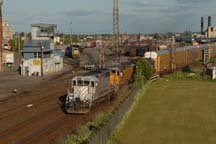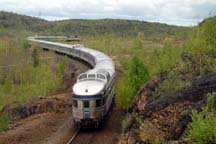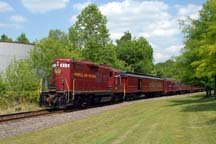When the Rochester Chapter of the National Railway Historical Society asked me to put on a program for their annual banquet, I thought it would be a great opportunity to transfer one of my multi-media slide shows to digital (taking advantage of my relatively new digital projector), so armed with my revised Up From the Apple show and my new Steaming Along program, I was Rochester-bound.
June 10, 2006
The weather was dull and overcast as I hit the road, following the ex-Erie main line along the Pennsylvania-New York border towards Binghamton. The dull weather meant I wasn't in any particular hurry to get trackside, so a bit of exploring was in order. My first stop was at the ex-Erie depot in Coshecton, New York, recently restored by the local historical society.
As I passed through Hancock, I realized I hadn't checked out the former New York, Ontario & Western depot in the nearby town of Cadosia in quite awhile. Once a major junction point on the O&W, Cadosia was where the coal line from Scranton joined the main line between Cornwall on the Hudson River and Oswego on Lake Ontario. The tracks have long been gone from Cadosia, and on my last visit the depot (converted to a bar) sat in a big open area next to what was once the marshalling yard for the O&W's coal trains. It took me a few minutes to find the depot on this trip, as the empty abandoned yards that surrounded the structure 20 years ago had grown in with trees, and I didn't recognize the area immediately. But soon I was at the depot (now a garden center) and noted that the freight house was also still standing. A large trestle had stood just behind the depot with a view down into Hancock, but growth has obliterated the view.
Next up was a stop in Binghamton, where a local freight for the New York, Susquehanna & Western was cutting locomotives out of the consist just south of town. They had some work to do, so I buzzed across the Susquehanna River to Conklin Yard (former Delaware & Hudson, now Canadian Pacific) where a coal train was backing in. A quick run down to Terrace Drive on the south end of the yard led to the discovery of a couple of switchers working, then it was back to the NYS&W, where the local freight was now ready to head into Binghamton. I caught it passing an eastbound train that was tied down waiting for a crew.
I had wanted to shoot the Susquehanna's passenger operation in Syracuse, so my next stop was at OnTrack's Syracuse University station, where I caught the Rail Diesel Car making its scheduled 2:20 p.m. stop. Thing was, it wasn't turning back to Syracuse like it was scheduled to, but instead was heading to the balloon festival at Jamestown Beach. The railroad was running special trains all day (no mention of this was made on their website when I had checked a few days earlier -- in fact, the schedules on the website, the schedules posted at the stations and the actual "official" schedule were completely different from each other). Not wanting to get caught up in balloon traffic, I headed west of Syracuse along the ex-New York Central (now CSX) main line and caught a westbound train (after heading all the way into downtown to the main OnTrack station to check the balloon festival schedule, since it wasn't posted at the outlying stations) then headed back to Jamesville (norrth of Jamesville Beach) to await the last northbound festival run. The local police were doing a booming business in Jamesville, picking off unsuspecting ballon fans as they passed through the town's speed traps. Much to my surprise, the northbound train wasn't the RDC's but was instead a locomotive-hauled passenger train. Duly recorded, I decided to head back to my spot on CSX west of town and shoot trains until dark, then make my way to Rochester.
 As I headed west, I noticed the solid bank of clouds appeared to end farther west, so I decided to drive until I reached sun and then stop. By the time I reached sun, I had covered about half of the 60 miles between Syracuse and Rochester, and a quick check of my watch indicated that I could get to downtown Rochester by 6:00 and attempt one of my "priority" shots of the trip, a CSX train crossing the Genesee Falls in downtown. Off to Rochester!
As I headed west, I noticed the solid bank of clouds appeared to end farther west, so I decided to drive until I reached sun and then stop. By the time I reached sun, I had covered about half of the 60 miles between Syracuse and Rochester, and a quick check of my watch indicated that I could get to downtown Rochester by 6:00 and attempt one of my "priority" shots of the trip, a CSX train crossing the Genesee Falls in downtown. Off to Rochester! Once I arrived at the falls, I was pleased to see that a lot of the seediness that I remembered from a previous trip had vanished. A nice park led to the footbridge that parallels the CSX bridge over the falls, and provided a very pleasant train-watching spot. CSX fully cooperated, and it wasn't long before I had three trains shot crossing the bridge. With that shot in the bag, I decided to try a couple of other spots recommended to me by local railfans, and headed towards the Main Street overpass at the west end of Goodman Street Yard. Once again CSX cooperated, and I had that shot accomplished in short order. back to the falls for one more train, then up to the Amtrak station (just east of the falls bridge) to shoot an Amtrak train just after sunset. Time for bed.
Once I arrived at the falls, I was pleased to see that a lot of the seediness that I remembered from a previous trip had vanished. A nice park led to the footbridge that parallels the CSX bridge over the falls, and provided a very pleasant train-watching spot. CSX fully cooperated, and it wasn't long before I had three trains shot crossing the bridge. With that shot in the bag, I decided to try a couple of other spots recommended to me by local railfans, and headed towards the Main Street overpass at the west end of Goodman Street Yard. Once again CSX cooperated, and I had that shot accomplished in short order. back to the falls for one more train, then up to the Amtrak station (just east of the falls bridge) to shoot an Amtrak train just after sunset. Time for bed.June 11, 2006
First quarry this morning was a shot of a train passing the Kodak building in downtown Rochester. An early morning eastbound Amtrak train was selected as the target, but arrival at the shot (just west of the falls bridge) was in time to get a late-running Lake Shore Limited in addition to the train I was seeking. With that shot accomplished (twice) I cruised around re-aquainting myself with Rochester, a city I hadn't visited for about ten years. Driving around, I eventually settled on CP 367 in the town of Brighton, just east of downtown and within sight of the east end of Goodman Yard. A train or two later and it was time to leave.
I was meeting Chris Hauf of the Rochester Chapter at the group's Rochester & Genesee Valley Railroad Museum in the town of Henrietta at a location known as Industry, where the Chapter has restored the Industry depot. Chris gave me a tour of all the Chapter's equipment and the restoration shop, then I rode a track car (can't call it a "speeder" because you'll scare the general public, even though it never tops five m.p.h.) over a mile and a half of track to another museum, the New York Museum of Transportation. While the R&GV Museum is devoted to the freight and passenger railroads of the region, the NYMT is more geared to streetcars and other non-rail transportation modes. I returned back to Industry on the speeder, then returned to CP 367 for some more CSX and Amtrak action (some of it even in sun!) before heading off to the banquet to put on my shows.
After the banquet I decided to try some night photos at CP 367, as it is guarded by two New York Central style signal bridges, complete with searchlight signals, at both ends of the interlocking. I caught two eastbounds side-by-side at the west end, then headed over to Goodman Street Yard for a couple of shots, then finished off with a westbound passing an eastbound at the east end of the interlocking. Another day in the bag.
June 12, 2006
The weather forecast for the next two days was bad, so I decided to cut the trip a day short and not head into Buffalo for a day of shooting. Instead, I got up at the motel (located just a few miles from the museum in Henrietta) and set out for Lakeville, home of the Livonia, Avon & Lakeville Railroad. A quick check at their office revealed that a train was heading for Rochester, so I headed back north and set up next to the museum building at Industry to get the train's passange. Been on the road for over an hour and I was only five minutes from my starting point. I continued the chase (there were two four-axle Alcos leading the train) to the south end of Rochester, then turned west with the railroad to Genesee Junction, where I somehow lost the train. Thinking that it might have turned south at the junction (it was supposed to go north to the Buffalo & Pittsburgh yard at Brooks Avenue, but it didn't appear that happened) I headed south as well. No sign of the train. Oh, well...
The tracks of the Dansville & Mount Morris appeared along the freeway as I headed south, and I decided that more exploring was in order. I got off the freeway and looked for any power the D&MM might have in Dansville. I didn't find power, but I did find the old passenger depot, located about a half mile below the current end of track. Thinking the power might be at the B&P interchange seven miles north, I followed the railroad to the interchange point, only to discover there was no yard (or power) there -- just tracks in the trees. Heading back to Dansville, I checked out what is probably the only customer on the railroad, the Foster Wheeler plant. If the railroad had any power, it was probably tucked inside the plant somewhere. Back on the road...
Next up was the B&H Rail shop in Cohocton, New York. I couldn't find anyone around to check in with, but I did find an ex-Minnesota Commercial six-axle Alco and a Bath & Hammondsport Alco switcher sitting outside the shop. Amazingly, the only sun of the day came out while shooting the two units together.
After passing through Bath I started keeping a watch out for the Bath & Hammondsport train that might be returning from the Norfolk Southern interchange at Gang Mills. Sure enough, I spotted the westbound train as I sped eastward on the freeway about seven miles outside Bath -- and I had just passed a freeway exit. I had to drive another five miles and then double back, but I was able to shoot the train (once again with two Alcos on the point) twice outside Bath and once passing the coal silos in town. The day was waning.
Passing Gang Mills yard, I heard a train on the radio get permission to pull up to the yard office. Then the dispatcher warned the crew to watch out for a westbound train that should be there by the time they reached the yard office. I got through Corning (the big town next to Gang Mills) and heard the radio announce the train's passing of a defect detector, which also announced the train's location. I could see the tracks as I drove along and -- there -- a milepost indicated that I was about four miles from the train and closing. Thankfully, there was an exit just a mile ahead that featured an overpass over the railroad, and I wasn't there long before bagging a westbound Canadian Pacific train operating over Norfolk Southern. Continuing eastward, I was passing the town of Owego when I heard another westbound calling signals. I got off at the next exit and U-turned back west for a 14-mile backtrack to Smithboro, where I caught the last train of the trip with Norfiolk Southern power.
A final check at Binghamton revealed nothing shootable at either end of Conklin Yard, and a return along NS down the Delaware River presented nothing before darkness set in east of Hancock. The trip was over.






